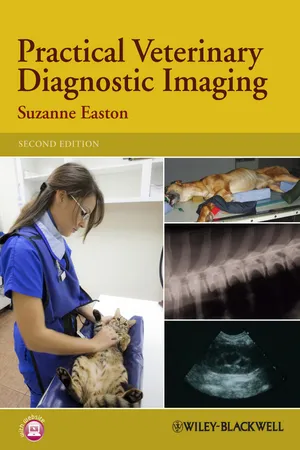
Practical Veterinary Diagnostic Imaging
Suzanne Easton
- English
- ePUB (mobile friendly)
- Available on iOS & Android
Practical Veterinary Diagnostic Imaging
Suzanne Easton
About This Book
Practical Veterinary Diagnostic Imaging is an essential and practical guide to the various diagnostic imaging modalities that are used in veterinary practice. It moves from basic mathematic and physical principles through to discussion of equipment and practical methods. Radiographic techniques for both small and large animals are covered. There is a separate chapter devoted to ultrasound, as well as discussion of advanced imaging techniques such as fluoroscopy, computerised tomography and magnetic resonance imaging. The book also covers legislation and safety issues in the context of their impact on the veterinary practice.
Presented with clear line diagrams and photographs, Practical Veterinary Diagnostic Imaging also provides revision points and self-assessment questions in each chapter to aid study. It is an ideal guide for student and qualified veterinary nurses. It is also a useful reference for veterinary students and veterinarians in general practice who want a basic guide to radiography and other imaging modalities.
KEY FEATURES
- Everything you need to know about diagnostic imaging in veterinary practice in a language you can easily understand
- The basic principles of physics presented in simple terms
- Improves your positioning techniques with practical tips for best practice
- Clear guidance on the use of digital imaging to improve image quality and reduce radiation doses to patients
- Companion website with additional resources (available at www.wiley.com/go/easton/diagnosticimaging )
Frequently asked questions
Information
| Matter | A collection of atoms and molecules |
| Mass | The measure of matter in an object |
| Weight | Mass under the influence of gravity |

| Energy type | Description | Example |
| Potential | The amount of work an object could do because of its position | An axe raised, ready to be brought down to chop, has potential energy |
| Kinetic | As an object leaves its state of potential energy, it gains kinetic energy | An apple gains kinetic energy as it falls out of a tree |
| Electrical | The movement of electrons inside a conductor after the application of a potential difference | The movement of electrons in a cable produces the electrical energy needed to make a bulb light up |
| Nuclear | Nuclear energy is the energy stored within the nucleus of an atom | This energy is formed when the nucleus of an atom is split |
| Thermal | The energy of a hot object. This is caused by the vibration of molecules within matter | A hot bath has faster moving molecules than a cool bath |
| Sound | The energy produced by sound vibrations | A musical instrument, engine noise, speech, thunder, diagnostic ultrasound, sonar |
| Chemical | The energy generated when a reaction occurs between two substances | Thermal energy produced when water is added to hot oil |
| Electromagnetic | Electric and magnetic energy moving in waves | X-ray production, radio waves, infrared light |